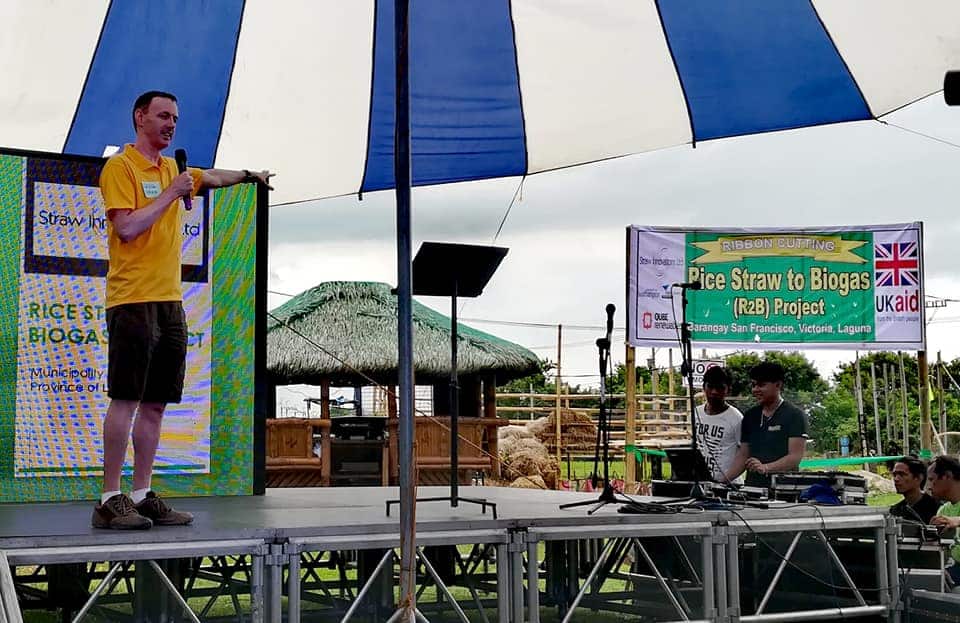
How one man is pioneering a rice revolution with biogas
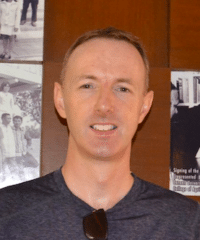 Craig Jamieson (left) is a man on a mission – to develop a major bioeconomy in the rice growing regions of the world. His pioneering approach is centred on anaerobic digestion. It gives farmers additional revenue streams and could remove more greenhouse gases from the atmosphere than are emitted by the global aviation industry – and stands on the cusp of success. Jon Hughes meets the self-styled bio-energy specialist.
Craig Jamieson (left) is a man on a mission – to develop a major bioeconomy in the rice growing regions of the world. His pioneering approach is centred on anaerobic digestion. It gives farmers additional revenue streams and could remove more greenhouse gases from the atmosphere than are emitted by the global aviation industry – and stands on the cusp of success. Jon Hughes meets the self-styled bio-energy specialist.
The hidden cost of rice farming
Rice is a staple food for over half the world’s population and the globe’s third largest farmed crop. The crop’s cultivation is also responsible for nearly half of all carbon emissions from global agriculture. Annually, the current methods of production emit more greenhouse gases (GHGs) than aviation, 1,000MT CO2(e)/yr compared to 918 MT CO2(e)/yr. That is a startling figure that flies under the radar in the climate debate.
The emissions put the crop into a cycle of decline. According to the International Food Policy Research Institute (IFPRI), without new technology and adjustments by farmers, climate change will by 2050 reduce irrigated rice yields by 15 percent and increase prices by between 113-121 percent. As most rice is cultivated by small farmers for local communities it is not just livelihoods but lives that are at risk.
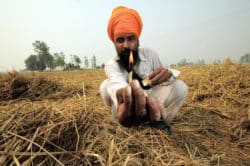
Why is rice cultivation so bad for the environment? There are several factors. One is the practice of burning rice straw. The scale of the problem is enormous. 300,000,000 tonnes of rice stubble a year is burnt across Asia, emitting not just CO2 but black carbon – which is both a climate forcing agent that serves to reverse the albedo effect, causing further global warming, and harmful to human health as a tiny carcinogen, causing hundreds of thousands of premature deaths every year.
The most famous manifestation of rice-stubble burning is the Asia brown cloud, which engulfs Delhi every November. IFPRI recently calculated that this practice creates an economic burden in North India of $30 billion each year.
Rice farmers have traditionally burnt the stubble because it is the most economic and efficient way of  clearing the land for a second crop. And while countries across Asia are seeking to outlaw the practice the alternatives to burning being proposed penalise the farmers through reduced yields.
clearing the land for a second crop. And while countries across Asia are seeking to outlaw the practice the alternatives to burning being proposed penalise the farmers through reduced yields.
The options actively being explored include: incorporating the straw into the paddy field, which turns it into a de facto aerobic digester, emitting methane. It also delays the establishment of the next crop; alternate wetting and drying, which again creates aerobic emissions and is critically reliant on complimentary weather, and; growing on uplands, which suffers from lower yields and has issues with weeds, leading to greater use of herbicides.
Networking triumph paves the way for rice revolution
Rural poverty was a problem that caught the attention of Craig Jamieson back in the noughties when he was undertaking some voluntary work in Asia. A successful horticulturist by profession, on his return to the UK he determined to take a Masters’ Degree in Sustainable Rural Development. He made bioenergy the subject of his thesis.

“It brought together my love of crops and rural businesses, environment and the social impacts I had witnessed through my voluntary work internationally. When I came to my thesis, I decided bioenergy was an exciting area for the future.”
To his surprise, he registered on the radar of the Low Carbon Vehicle Network who invited him to speak at a conference in Mayfair, London, on biofuel sustainability.
It was a fortuitous moment as Jamieson was on his uppers, having turned down offers to return to horticulture to pursue his belief in bioenergy as a key to sustainable development. Jamieson recalls, “I had this idea that biofuels could be produced without competing with food production, which was the massive issue of the time. I was a nobody, yet I shared the stage with Government ministers, top consultants, business leaders and other high-profile people in that space.
“I felt a bit out of my depth, but my presentation went down well, and the delegates voted me as the best speaker in the conference! As a result, the organisers gave me a little bit of money to do some consultancy about what I had presented and make a report for them. In those days, people joked that the only way to make money out of bioenergy was to become a consultant!”
A succession of consultancies followed, including for the UK government. Then Jamieson determined it was time to walk the talk. Having frequently visited the Philippines and made connections with scientists at the International Rice Research Institute, in 2012 he decided to take the plunge and moved to an agricultural research centre just south of Manila.
Rice stubble – a bioenergy and sustainable development dream
The town where he settled – Los Baños – is home to the International Rice Research Institute which since its establishment in 1960 it has helped save one billion people from starvation through the Green Revolution. However, they had not done so much work on rice straw, which was becoming a major problem in the intensive systems across Asia.
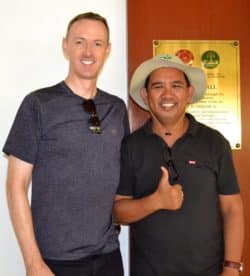
They didn’t however have a biomass specialist. Jamieson offered to act as a consultant to try and get some funding for research from the UK Government to fill the knowledge gap. “I entered a competition, brought together a consortium and was successful in securing funds for a three-year initial project to look at why rice straw is not being used for bioenergy. I ended up leading that project, which was one of the most comprehensive studies that had been done on the subject.” He adds, somewhat modestly, “since it was so under-researched”.
“As a bioenergy specialist the potential of rice stubble made me drool,” says Jamieson. “All around the world the hunt has been on for a large amount of biomass that can be used for delivering clean energy without competing with anything else and we have 300m tonnes of it being burnt. That’s a clear indicator that it’s there for the taking – a potentially vast resource that can be used for bioenergy and food production.”
The digestate from the dry-AD process has been found to be an excellent growing medium for mushrooms, giving farmers an additional revenue stream. Under the system the digestate is not required by the crop as the roots of the rice stubble left in the ground act as a carbon store for the soil.
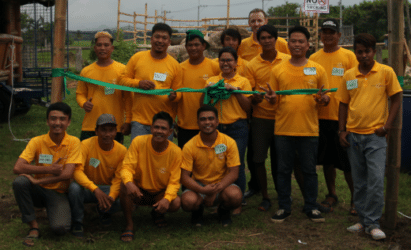
When the project ended in 2016, Jamieson says, “We were in an amazing position, so I just kept going and started my own company, Straw Innovations. I invested my life savings into it, got another three year’s co-funding from the UK Government, led a team of scientists and technology providers and built my own team of locals who helped set up an industrialised pilot plant here. My dream was becoming a reality before my eyes.”
The plant needed to be biogas because rice straw is poor for combustion; it has about 15% silica, which is extremely high and causes problems in thermal systems, and in the rainy season, the straw is wet.
“Biogas resolves these issues, and enables smaller, localised plants to be built too, since you don’t want to transport straw long distances. However, it’s difficult to get out of the fields and it breaks down slowly, which are some of the challenges we’ve been working to address.”
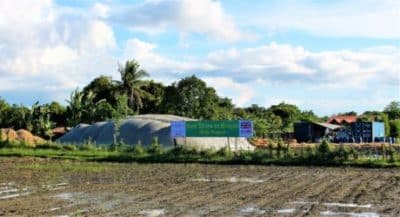
The first pilot plant was supplied by UK-based Qube Renewables based on kit specially designed for the dry-AD of straw. It worked. Having proved the potential of the technology, Jamieson is now seeking to enhance the system.
AD can be a catalyst for a major bio-economy – “that’s what inspires me”
“We now want to get it to commercial scale. We’re improving the efficiency of our straw harvesting and transport system, which is critically important. And we are looking to develop our own design of digesters for rice straw that can be simply fabricated here in the Philippines. Our vision is to support rice farmers and local entrepreneurs across Asia with our know-how and specially adapted suite of technologies through a franchise business model.”
This phase of the project has won funding from Innovate UK to help towards this over the next two years, after which Jamieson plans to go to commercial scale.
“We’re not only eyeing up ways to reduce emissions – critical though that is. By clearing away the straw from the fields after harvest, farmers can get started straight away on another crop of rice, enabling them to grow three crops a year instead of just two. The implications of that for rural poverty alleviation and food security are immense. And Asia’s 300 million tonnes of rice straw that are currently being burned can become the starting point for a major bioeconomy. That’s what inspires me to keep pushing on to help make it happen,” Jamieson says.
Jamieson’s extraordinary vision, passion and tenacity could truly change the world for better – for the rice farmers of Asia and for the planet – by removing a greater quantity of greenhouse gases from the atmosphere than is produced by the global aviation industry. It is yet another example of how AD sits at the heart of a circular economy and how there is no net zero without biogas.

